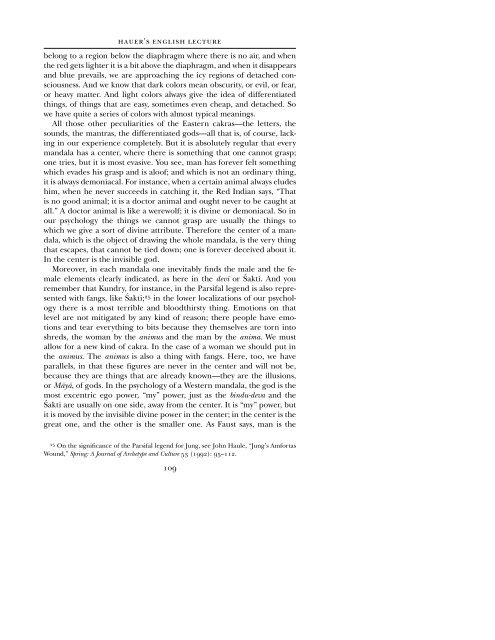CG JUNG - Countryside Anarchist
CG JUNG - Countryside Anarchist
CG JUNG - Countryside Anarchist
You also want an ePaper? Increase the reach of your titles
YUMPU automatically turns print PDFs into web optimized ePapers that Google loves.
HAUER'S ENGLISH LECTURE<br />
belong to a region below the diaphragm where there is no air, and when<br />
the red gets lighter it is a bit above the diaphragm, and when it disappears<br />
and blue prevails, we are approaching the icy regions of detached consciousness.<br />
And we know that dark colors mean obscurity, or evil, or fear,<br />
or heavy matter. And light colors always give the idea of differentiated<br />
things, of things that are easy, sometimes even cheap, and detached. So<br />
we have quite a series of colors with almost typical meanings.<br />
All those other peculiarities of the Eastern cakras—the letters, the<br />
sounds, the mantras, the differentiated gods—all that is, of course, lacking<br />
in our experience completely. But it is absolutely regular that every<br />
mandala has a center, where there is something that one cannot grasp;<br />
one tries, but it is most evasive. You see, man has forever felt something<br />
which evades his grasp and is aloof; and which is not an ordinary thing,<br />
it is always demoniacal. For instance, when a certain animal always eludes<br />
him, when he never succeeds in catching it, the Red Indian says, “That<br />
is no good animal; it is a doctor animal and ought never to be caught at<br />
all.” A doctor animal is like a werewolf; it is divine or demoniacal. So in<br />
our psychology the things we cannot grasp are usually the things to<br />
which we give a sort of divine attribute. Therefore the center of a mandala,<br />
which is the object of drawing the whole mandala, is the very thing<br />
that escapes, that cannot be tied down; one is forever deceived about it.<br />
In the center is the invisible god.<br />
Moreover, in each mandala one inevitably finds the male and the female<br />
elements clearly indicated, as here in the devz or åakti. And you<br />
remember that Kundry, for instance, in the Parsifal legend is also represented<br />
with fangs, like åakti; 25 in the lower localizations of our psychology<br />
there is a most terrible and bloodthirsty thing. Emotions on that<br />
level are not mitigated by any kind of reason; there people have emotions<br />
and tear everything to bits because they themselves are torn into<br />
shreds, the woman by the animus and the man by the anima. We must<br />
allow for a new kind of cakra. In the case of a woman we should put in<br />
the animus. Theanimus is also a thing with fangs. Here, too, we have<br />
parallels, in that these figures are never in the center and will not be,<br />
because they are things that are already known—they are the illusions,<br />
or Mvyv, of gods. In the psychology of a Western mandala, the god is the<br />
most excentric ego power, “my” power, just as the bindu-deva and the<br />
åakti are usually on one side, away from the center. It is “my” power, but<br />
it is moved by the invisible divine power in the center; in the center is the<br />
great one, and the other is the smaller one. As Faust says, man is the<br />
25 On the significance of the Parsifal legend for Jung, see John Haule, “Jung’s Amfortas<br />
Wound,” Spring: A Journal of Archetype and Culture 53 (1992): 95–112.<br />
109


